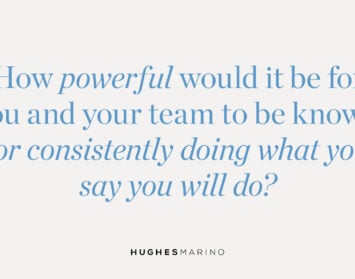By Anna Quattlebaum
Coloring Creative on the Commercial Real Estate Canvas
I’m a corporate real estate broker with award-winning real estate advisory firm, Hughes Marino. We help business leaders make great real estate decisions for their growing teams.
I’m also an artist, which, as it turns out, informs my approach to leading high value projects for my clients. You see, when I create art, I always break it down into four stages:
- Stage 1: See things with absolute clarity
- Stage 2: Understand what it is that I am seeing (hint—this isn’t always obvious)
- Stage 3: Have a crystal-clear vision of what I intend to create
- Stage 4: Go for it, make art, do my thing as only I can do it
So, how does this apply in complex, high-value real estate projects?
1. See things clearly.
Some might call this ‘qualifying the opportunity.’ Be pragmatic, understand what is possible and what isn’t. Be clear-eyed as you head into new projects in order to set reasonable expectations, lay out all possibilities and be able to express these things clearly. We work with amazing people running remarkable companies. Our clients are busy, and they trust us to take the lead on their high-impact real estate planning and decision making. How we kick off a project sets the tone for everything that follows. So, let’s think things through and make sure we see and communicate a clear path ahead.
2. Understand what you are seeing.
As the market expert, I need to understand the context in which things are happening. I need to be a master of my marketplace. I know who your landlord is, I know the last three transactions they signed and I know the concessions they offered. I also know that the building is currently 40% vacant and their loan is coming due in the first quarter next year. I also know that on their last quarter’s investor conference call (because I listened in), they expressed confidence in raising their occupancy to at least an 80% level, which means they are under tremendous pressure to deliver on that promise and meet the street’s expectations. Point being—I know my market cold. This is just basic table stakes.
3. Have a clear vision of what you intend to create.
Here’s the thing. I am going to be negotiating this transaction on your behalf. You are the client, and the final decisions will be yours. It’s your space, and it’s your transaction. The only definition of success that matters is if, when we get to the finish line, you deem the project to be a success. So, I had better understand what you are looking to achieve and what matters most to you. I need to start by asking questions. As a mentor of mine often says, “prescription without diagnosis is malpractice.” This is what I mean by having a clear vision of what “we” intend to create. It is sometimes called Workplace Strategy, and it is about asking questions and gathering data from you, the client, in order to inform the work I will do on your behalf.
4. Do my thing as only I can do it.
Differentiation in the marketplace of ideas is, I believe, automatic. We are all different. I happen to be a people person. So, for me, this business of corporate real estate, bricks and mortar, isn’t about the buildings. It’s about the people. That’s just who I am. Let me show you how I approach this business of corporate real estate. Let me show you how I lead projects, solve problems and get things done.
Let’s make some art.







